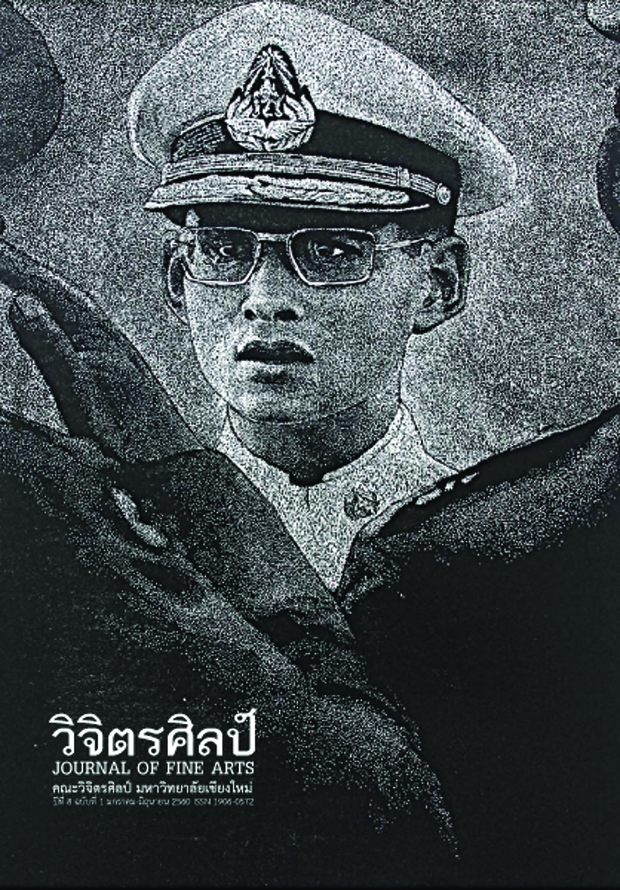แนวทางในการพัฒนาศักยภาพทางการออกแบบผลิตภัณฑ์แฟชั่นประเภทกระเป๋าจากเศษผ้า : กรณีศึกษา ผ้าทอไทลื้อบ้านเฮี้ย อำเภอปัว จังหวัดน่าน
Main Article Content
Abstract
การวิจัยนี้มีวัตถุประสงค์เพื่อ 1.) ค้นหาแนวทางในการสร้างมูลค่าเพิ่มด้วยการออกแบบผลิตภัณฑ์แฟชั่นประเภทกระเป๋าจากเศษผ้าทอไทลื้อเหลือใช้จากกระบวนการตัดจากชุมชนบ้านเฮี้ย อำเภอปัว จังหวัดน่าน 2.) นำเสนอรูปแบบผลงานการออกแบบผลิตภัณฑ์แฟชั่นประเภทกระเป๋าจากเศษผ้าทอไทลื้อเหลือใช้จากกระบวนการตัดให้แก่ชุมชนบ้านเฮี้ย อำเภอปัว จังหวัดน่าน โดยใช้การวิจัยแบบผสมผสาน ได้แก่ การวิจัยเชิงคุณภาพ (Quality Research) ผู้วิจัยทำการศึกษาเอกสารที่เกี่ยวข้องและสัมภาษณ์เชิงลึก (Depth Interview) แบบตัวต่อตัว (Face - to-Face –Interview) กับผู้นำของชุมชน นักวิชาการและนักออกแบบ และการวิจัยเชิงปริมาณ ผู้วิจัยใช้ทำแบบสอบถาม(Questionnaire) เก็บข้อมูลจากกลุ่มตัวอย่างจำนวน 50 คน จากนั้นวิเคราะห์ผลที่ได้เพื่อนำไปสู่ขั้นตอนในการออกแบบ
ผลการวิจัยพบว่า 1.) ผู้วิจัยค้นพบองค์ประกอบของการพัฒนาศักยภาพทางการออกแบบผลิตภัณฑ์แฟชั่นประเภทกระเป๋าจากเศษผ้าทอเหลือใช้จากกระบวนการตัด ที่สามารถสร้างมูลค่าเพิ่มให้กับผลิตภัณฑ์กระเป๋าที่เหมาะสมกับศักยภาพของชุมชน และสร้างแนวทางจำนวน 3 แนวทางที่เหมาะสมกับศักยภาพเดิมของชุมชน 2.) ผู้วิจัยนำเสนอผลงานการออกแบบผลิตภัณฑ์แฟชั่นประเภทกระเป๋าให้แก่ชุมชนทอผ้าบ้านเฮี้ย อำเภอปัว จังหวัดน่าน โดยผลิตกระเป๋าจำนวน 3 แบบตาม 3 แนวทางที่ค้นพบ เพื่อพัฒนาเป็นต้นแบบกระเป๋าจากเศษผ้าให้แก่ชุมชน ส่งผลให้ชุมชนเกิดประสิทธิภาพในการเรียนรู้และเข้าใจ สามารถพัฒนาศักยภาพในการออกแบบของชุมชนให้อยู่ได้เองอย่างยั่งยืน
A Research of proficiency development in fashion design product; bag
made from remnant fabric: Case study of Tai-lue hand woven fabric, Baan Hia, Pua District, Naan Province
The purposes of this study were 1) to research for guidelines on how to add value by designing fashion bags from remnants of Tai-Lue hand-woven fabric, Baan Hia, Pua District, Naan Province, 2) to present fashion bags made from remnants of Tai-Lue hand-woven fabric from the same community. In this research, the researcher used mixed methods research. For qualitative research, the researcher studied about related documents and used in-depth interviews and for quantitative research, the researcher collected data from a sample group of 50 women using questionnaires. All the data was analyzed to apply in the design process.
The research found that 1) the community has the capacity to develop the new methods for increasing the value of the bag made from remnant fabrics and its model, and there are 3 methods which are suitable for the community's tailoring and decoration skills, 2) there are 3 prototypes which are based on 3 methods which were presented to the public.
From these above factors, supporting the community to improve efficiency in their learning and understanding increases their potential of design to be well-organized and sustainable as well as a model of development for people in the community.


